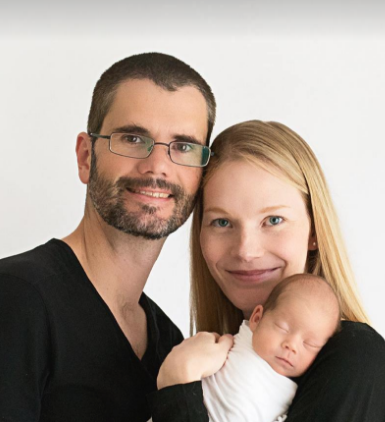Are Churches Holy?
by Stephen Ferguson | 22 May 2024 |
When my wife and I took a five-week family holiday to France, we were impressed by the many beautiful buildings—places such as Versailles, Fontainebleau, and the Louvre.
But what really blew us away were the stunning churches. In addition to Paris’ famous Notre Dame (currently undergoing repairs), we also saw Strasbourg Cathedral (one of Europe’s tallest), the Reims Cathedral (where kings of France used to be crowned), and the Sacré-Coeur Basilica (probably the best view of Paris). My favorite of them all is the Mont-Saint-Michel monastery in Normandy, a combination of medieval skyscraper and Disney-style fairytale castle.
Even at the local level, every one-horse town or farming village has an impressive ecclesiastical structure, which puts modern mega churches to shame. The church buildings we saw were all so amazing.
But all so empty.
When Notre Dame Cathedral nearly burnt to the ground in 2019, there was an outpouring of grief from all corners of France and the whole world. Celebrities and business titans donated millions to see the building restored. At current estimates, and with the prestige of the French Government at stake, the church could be totally repaired in time for the 2024 Paris Olympics.
I couldn’t help but see the irony of this outpouring of affection, though, from one of the most secular countries in the world. It seemed people love this religious building—just not the religion that occupies it.
Even among those who profess to be Christians, only about 4% of the French attend church regularly. This was apparent when seeing the paltry few chairs put aside for a few dozen worshippers, in buildings originally designed for thousands.
Many of these churches and cathedrals had signs and brochures explaining that they had been taken over by the French government, as there were no longer enough congregants to pay for their upkeep. The buildings were now in effect government-run museums, not places for actively worshiping God.
Is church a building?
Our tour of these ancient, magnificent, but empty church buildings made me wonder: what, exactly, makes a church? Is it a building—or the people who use it? Did Notre Dame Cathedral cease to exist in 2019 when the building burnt down—or had that church already ceased when it lost its living religious community?
To risk explaining what many of you already know: the English word “church” comes from the Greek word ekklesia, which is translated as “assembly of people.” A similar idea is behind the word “synagogue,” which also, in Greek, originally meant “an assembly, either the place or people gathered together.”
Significantly, in the New Testament a church is not a temple. A temple or sanctuary in Greek is naos, meaning a divine dwelling place for God, or in the case of pagan religions, gods.
The first Christians did not think of church in terms of buildings, but assemblies of people. The first Christians didn’t have dedicated sacred spaces; they typically met in houses, and in at least one case, on a riverbank.
If early Christians contemplated an inherently sacred building, they used the word temple, which in New Testament times still meant Herod’s temple in Jerusalem. Yet somehow in the evolution of Christian history, probably after Herod’s temple was destroyed by the Romans in 70 CE, the notion of church morphed from assembly to something more synonymous with temple.
Sanctuaries made of flesh
A central theme of the New Testament, if not the entire Bible, is that there are no inherently sacred buildings. People can make a place holy, but bricks and mortar have no intrinsic holiness.
As observed by 20th-century rabbi Abraham Joshua Heschel, it was human beings – not God – who drove the establishment of a physical temple with temporal sacrificial services. Heschel insisted it was the Sabbath, which is to say, time itself which was Judaism’s great and indestructible cathedral. A physical structure was not part of God’s original plan but rather
“It was only after the people had succumbed to the temptation of worshiping a thing, a golden calf, that the erection of the Tabernacle, of holiness in space, was commanded. The sanctity of time came first, the sanctity of man came second, and the sanctity of space came last.”
The Apostle Paul shares similar sentiments in a discussion with pagan Greeks in Athens:
“The God who made the world and everything in it is the Lord of heavens and earth and does not live in temples made by human hands” (Acts 17:24).
Both in the Old Testament and the New, what seems to make a space sacred is its occupation by God’s people:
- When the Children of Israel left Egypt, God dwelt in a mere tent. God was reluctant to allow a permanent physical building (2 Sam. 7:1-7; 1 Chron. 17:4-6).
- David was denied the opportunity to build God a house of stone, in part because David was commanded instead to build a house of flesh—that is, his bloodline (2 Sam. 7:11, 16)—which was ultimately fulfilled in Jesus the heir of David (Matt. 21:9).
- Jesus was in fact the true Temple, who was destroyed and rebuilt in three days (John 2:19-21; Heb. 10:20).
- The temple services that the physical building enabled, such as animal sacrifice, did not please God (Hosea 6:6; Amos 5:22-23) and were merely symbols pointing to Jesus’ death on the cross (Heb. 10:1-12).
- Humanity was made to image God on earth (Gen. 1:27), and as God’s images we too are temples of the Holy Spirit who dwells within us (1 Cor. 6:19-20).
- Human bodies – not bricks – are the real temples of God, and extensions of the body of God on earth, led by Christ as the head (Col. 1:18; 2 Cor. 5:20).
- Whenever two or more people are gathered together, that is where God dwells as a church, regardless of location or setting (Matt 18:20).
- Ironically, especially in light of the current fight over “sacred” places in the Middle East, Jesus said it doesn’t really matter where you worship God—in what structure, on what mountain, or in what country (John 4:20-23).
Holy cows, profane calves
Not only are buildings not inherently holy, the Bible seems to teach that sacred structures can become unholy. Sacred places can turn profane.
This seems to be the prophetic message of Stephen, the first Christian martyr, as recorded in the book of Acts. Stephen, a Greek-speaking Hellenistic Jew, gets into an argument with others, and is arrested by the Jewish religious authorities. Note the charges:
“This man never stops saying things against this holy place and the law” (Acts 6:13).
Stephen’s subsequent speech in Acts 7 never quite refutes these accusations. The punchline of Stephen’s long speech is the status of Jerusalem’s temple. Stephen notes that it began as a tabernacle in the wilderness, then was physically built as a permanent structure by Solomon. Stephen paraphrases the prophet Isaiah (Is. 66:1-2), suggesting this physical structure was now theologically irrelevant:
“But it was Solomon who built a house for him. Yet the Most High does not dwell in houses made with human hands.” Heaven is my throne, and the earth is my footstool. What kind of house will you build for me? says the Lord. Or where will my resting place be? (Acts 7:47-49)
Stephen’s criticism of the temple was that it is a structure “made with human hands,” and God does not dwell in human-made places.
Stephen’s insults get worse. Earlier in the speech he pays special attention to the only other thing of note that Israel made with human hands: the golden calf:
“That was the time they made an idol in the form of a calf. They brought sacrifices to it and reveled in what their own hands had made” (Acts 7:42).
Stephen was making an observation similar to Rabbi Heschel’s. As further noted by Christian scholar Jonathan Hill:
“Stephen gives a long speech to the council about the patriarchs and prophets, concluding that the Jews have always persecuted those whom God sent, and describing the building of the Temple itself as a sign of the rejection of God by Solomon, for God cannot be located in a physical building” (Jonathan Hill, Christianity: The First 400 Years. Oxford: Lion Books, 2013. p.67).
Stephen was suggesting that the whole edifice of the then-Jewish aristocracy—the rights and privileges of a priestly class all stemming from being associated with the rites of the Jerusalem temple—meant nothing. In fact, it meant less than nothing, as the temple had become a form of idol worship. This explains why the Sanhedrin’s reaction was immediate and dramatic:
“They were enraged and ground their teeth at Stephen…. Then they dragged him out of the city and began to stone him” (Acts 7:54,58).
Stephen’s martyrdom over the meaning of the temple profaned the temple.
Shhh, keep quiet!
What are the implications of recognizing that church buildings are not inherently sacred, but in fact can become profane? How do we treat church and churches if God dwells inside us humans made of flesh rather than mere structures made of brick or stone?
From a practical point of view, I think this helps to address the ongoing worship wars. As the thinking often goes, the church building—especially the so-called “sanctuary”—cannot be used for certain worldly activities, nor can certain kinds of emotions be expressed within it. There is a sense that only silent, sacred solemnity is permitted within these walls. Talking, laughing, and clapping are prohibited.
Children, in particular, must be seen and not heard. They should not eat. They should not play games or do anything supposedly disrespectful of the sanctity of the place. If in doubt, don’t let them do anything that comes even close to being fun.
However, based on a proper understanding of who or what church is, I am not sure that represents good theology. While I don’t deny there might be times when silent solemnity is appropriate, I would think this arises by virtue of the occasion, rather than some inherent quality in the bricks and mortar housing the congregants.
Just as we humans are God’s true temples on earth, and there are times when we laugh and cry, praise God in joy, and lie down in anguished lament, eat and fast, and dance and sleep, so, it seems to me, church property should reflect this full range.
The church is not about a title, property, or managerial structure
More broadly: the Seventh-day Adventist Church is not the registered corporation, its property, or assets, any more than Herod’s temple and its religious elite were. God dwells in God’s people. It is partly for this reason, as others have rightly observed, Ted Wilson is not the president of the Seventh-day Adventist World Church, but merely president of the General Conference of Seventh-day Adventists.
The fact that something sacred can become profane – even the temple in Jerusalem – suggests one cannot simply claim divine authority based on an external title, asset, or organizational status. That includes the General Conference. God continuously rules the church through God’s people, even as nomenclature, property, and managerial structures change.
Organization matters and is helpful, just like an ox that pulls a cart. But sacred cows become a problem when you cover them in gold and start worshiping them.
 Stephen Ferguson is a lawyer from Perth, Western Australia, with expertise in planning, environment, immigration, and administrative-government law. He is married to Amy and has two children, William and Eloise. Stephen is a member of the Livingston Adventist Church.
Stephen Ferguson is a lawyer from Perth, Western Australia, with expertise in planning, environment, immigration, and administrative-government law. He is married to Amy and has two children, William and Eloise. Stephen is a member of the Livingston Adventist Church.




